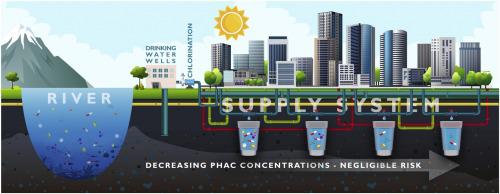Journal of Water Process Engineering ( IF 6.3 ) Pub Date : 2021-03-30 , DOI: 10.1016/j.jwpe.2021.102039 Attila Csaba Kondor , Éva Molnár , Anna Vancsik , Tibor Filep , József Szeberényi , Lili Szabó , Gábor Maász , Zsolt Pirger , András Weiperth , Árpád Ferincz , Ádám Staszny , Péter Dobosy , Katalin Horváthné Kiss , Gergely Jakab , Zoltán Szalai

|
The presence of pharmaceutically active compounds (PhACs) in drinking waters might pose a serious threat to human health worldwide. Therefore, this study sought to measure PhACs in Danube-derived tap water from the Budapest metropolitan region (Hungary), and to compare the results of those measured in the bank filtrate after which a human health risk assessment (based on human risk quotient [hRQ]) was conducted for the detected PhACs. A total of 108 samples were collected from 21 sampling sites throughout 6 sampling campaigns. Our study screened for 102 PhACs, of which 19 were detected in the persistently chlorinated tap water samples. PhAC concentrations were much lower than previously assumed based on the contamination of raw water resources. The total mean concentration of the analyzed PhACs exceeded 30 ng L−1 only at 5 sites. Moreover, the frequency of occurrence (FRO) of the 6 most common compounds (carbamazepine, lamotrigine, lidocaine, benzoylecgonine, tramadol, and cinolazepam) reached 50 % at 4 sites. The most frequent PhAC was carbamazepine (FRO = 53.7 %), the risk level of all PhACs investigated was negligible (hRQ<1) with carbamazepine having the highest hRQs (hRQMAX = 0.007; hRQMEAN = 0.001). Tap water provided lower PhAC concentrations farther from the water abstraction wells and treatment stations along the Danube. The travel time between the drinking water wells and taps with other factors, such as the varying microbiological pattern and the deposits in the supply system influence the PhAC concentrations. Based on the risk assessment, all investigated PhACs pose a negligible risk to consumers in the investigated urban area.
中文翻译:

河岸过滤饮用水中药物活性化合物的发生及健康风险评价。
饮用水中存在药物活性化合物(PhAC)可能对全世界的人类健康构成严重威胁。因此,本研究试图测量布达佩斯首都圈(匈牙利)多瑙河自来水中的PhAC,并比较在银行滤液中测量的结果,然后进行人类健康风险评估(基于人类风险商[hRQ ])进行检测到的PhAC。在6个采样活动中,从21个采样点总共采集了108个样品。我们的研究筛选了102种PhAC,其中19种在持续氯化的自来水样品中被检测到。PhAC的浓度远低于原水污染造成的先前假设。分析的PhAC的总平均浓度超过30 ng L -1仅在5个站点上。此外,6个最常见化合物(卡马西平,拉莫三嗪,利多卡因,苯甲酰基芽子碱,曲马多和cinolazepam)的发生频率(FRO)在4个部位达到50%。最常见的是PHAC卡马西平(FRO = 53.7%),所有PhACs的风险水平研究是可以忽略的(HRQ <1)与具有最高hRQs(HRQ卡马西平MAX = 0.007; HRQ MEAN= 0.001)。自来水距离多瑙河的取水井和处理站较远,其PhAC浓度较低。饮用水井和水龙头之间的行进时间受其他因素影响,例如微生物模式的变化和供水系统中的沉积物会影响PhAC的浓度。根据风险评估,所有被调查的PhAC对所调查城市地区的消费者构成的风险可忽略不计。











































 京公网安备 11010802027423号
京公网安备 11010802027423号